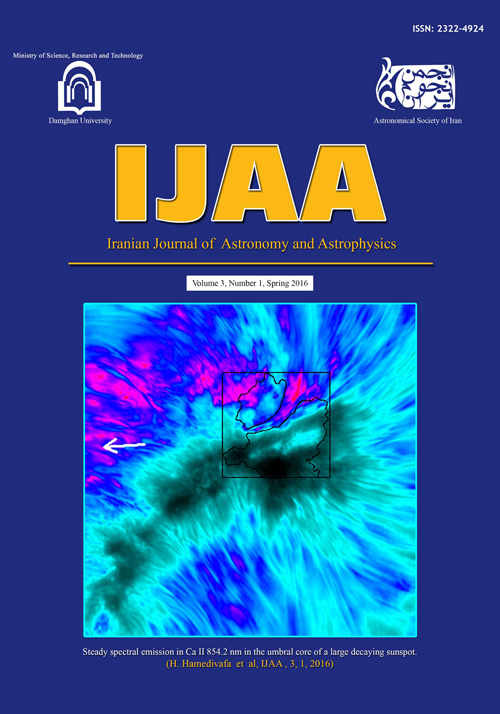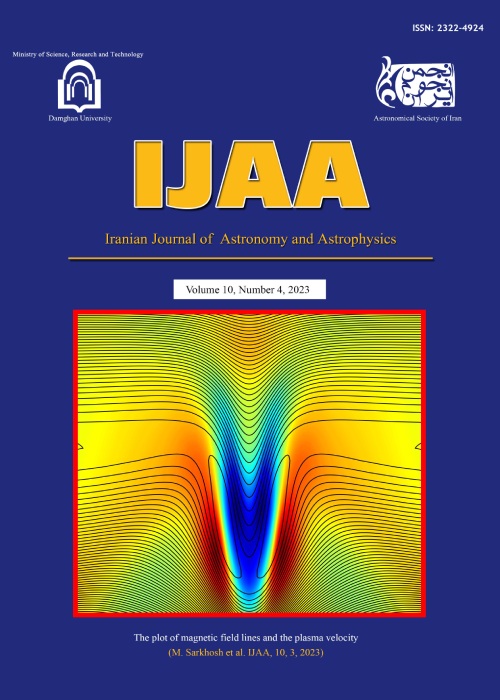فهرست مطالب

Iranian Journal of Astronomy and Astrophysic
Volume:3 Issue: 1, Spring 2016
- تاریخ انتشار: 1395/12/02
- تعداد عناوین: 6
-
-
Pages 1-13A lot of absorption lines are in the bluewards of Lyα emission line of quasar which is well-known as Lyαforest. Most of absorption lines in this forest belong to the Lyα absorption of the neutral hydrogen in the inter-galactic medium (IGM). For high redshift quasars and in the continuum with low and medium resolution, there are no many regions without absorption, so that, the quasar continuum in the forest is not obvious. Determination of the continuum in the forest is essential to study material distribution in the IGM, which is conductible through these absorption lines. One way to find this continuum is to predict it using longer wavelengths of the Lyα emission line of quasar, redwards of quasar continuum. Principal component analysis (PCA) method was proposed by researcher to estimate the bluewards of 50 low redshift quasars with 9% mean absolute error (error range was3-30%). In this article, the whole continuum is predicted using only the redwards of the quasar continuum and ten random data of the forest by an artificial neural network (ANN). Five different training algorithms are used to train the ANN. The simulation results show that mean absolute error for the Lyα forest is decreased to 5.27% (with error range between 1.63-9.05%). These results verify the capability of the ANN to predict the quasar continuum in the Lyαforest as compared with the statistical methods.Keywords: Quasar, Lyα Forest, Neural Networks, continuum
-
Pages 15-24A total lunar eclipse is conjectured to have influence on the physical conditions of an environmental area, particularly on the brightness of the sky. The phenomenon might also be relevant on weather parameters change on Earth, such as temperature, humidity and pressure, though a straightforward correlation is not easy to establish. This work mainly aims at measuring the brightness of the sky and also meteorological variables like temperature, humidity, and pressure during the total lunar eclipse that occurred on April 14 and 15, 2014, by using sensors registering the variation of luminance, and a weather station. Analysis of the changes in the sky brightness during all the eclipsing event allows for the observing conditions to be quantified and rated according to various international scales.Keywords: Sky Quality, Brightness, Lunar Eclipse, Weather, Dark Skies
-
Pages 25-45In the present work, we introduce and explain a method of solution of the radiative transfer equation based on a thin cloud model. The efficiency of this method to retrieve dynamical chromospheric parameters from Stokes I profiles of Ca II 854.2 nm line showing spectral emission is investigated. The analyzed data were recorded with the Crisp Imaging Spectro-Polarimeter (CRISP) at Swedish 1-m Solar Telescope on La Palma on 2012 May 5 between 8:11 - 9:00 UT. The target was a large decaying sunspot (NOAA 11471) at heliocentric position W 15◦ S 19◦. This sunspot has a large umbra divided into two umbral cores (UCs). One of these UCs shows steady spectral emission in both Ca II 854.2 nm and H_ lines, where downflows prevail. The other UC shows intermittent spectral emission only in Ca II 854.2 nm, when umbral flashes are propagating. The statistics of the obtained Doppler velocities in both UCs is discussed.Keywords: Sun: sunspots
-
Pages 47-55Propagation of dust ion acoustic waves in plasmas composed of nonthermal distributed electrons and stationary dust particles is investigated. Nonlinear Schrdinger equation is derived to describe small amplitude waves, using the reduction perturbation technique. Modulation instability of dust ion acoustic waves is analysed for this system. Parametric investigation indicates that growth rate of the modulational instability is sensitive to the value of non-thermal parameter and relative density of plasma constituents.Keywords: Modulational instability, dust ion acoustic waves, non, thermal electrons, Nonlinear Schrdinger equation
-
Pages 57-64The Earths atmosphere is an environment replete with particles of differ-ent sizes with various refractive indices which affect the light radiation traveling through it. The Mie scattering theory is one of the well-known light scattering techniques ap-plicable to modeling of electromagnetic scattering from tiny atmospheric particles or aerosols floating in the air or within the clouds. In this study, the scattering charac-teristics of atmospheric particles are investigated for a wide range of particle types and particle sizes within the framework of Mies theory. The scattering and back-scattering coefficients are calculated and it is observed that the maximum scattering occurs for particle sizes comparable to the radiation wavelength while the spherical particles with diameters much greater than the wavelength scatter the least. The calculations were carried out in the MATLAB environment and the results demonstrate that the scat-tering anisotropy has a direct relation with diameter of the particles.Keywords: Light Scattering, Electromagnetic Absorption, Mie theory
-
Pages 65-72The damages and logical failures in di erent parts of a satellite may occur during a solar event, when a bulk of solar energetic particles approaching the Earth. During solar events, these particles may cause extensive damages which are even permanent (hard errors). A way of damage reduction is designing a proper coating as the fuselage. As protons are the major component of solar particles and because the most of hard errors are caused by neutrons, in this work, we evaluated di erent shielding material against these type of errors. To avoid hard errors due to neutrons, we need to know solar energetic particles ux. During a solar are a satellite receives the maximum ux of protons, so we used protons with an energy range of 100 MeV to 1 GeV which is the most sensitive energy range to the Sun activities. In the present work, we have calculated the ux of solar energetic particles which collides a typical satellite in low earth orbit. Using OMERE software, coordinates and speci cations of a satellite were determined virtually and this typical satellite were used to calculate the typical values of particles uxes received by satellite during di erent solar ares of di erent solar cycles during occurrence of solar ares. Then, we have used FLUKA software, to study 10 di erent material layers as typical fuselages assuming proton primaries collide with them in the above energy ranges. Then we calculated neutron uxes produced when a proton interacts with these materials. At the nal stage we have shown that in this energy ranges Aluminum makes the best shielding against solar particles and adding Magnesium to alloy may improve the fuselage protection against hard errors.Keywords: Space weather, Cosmic Rays, Simulation, Solar flares, Shielding


